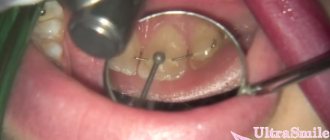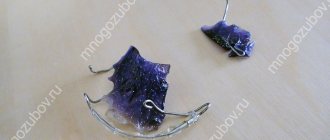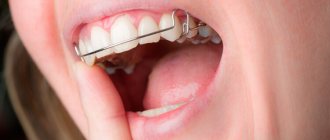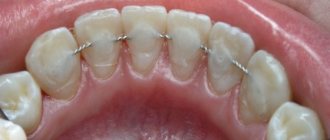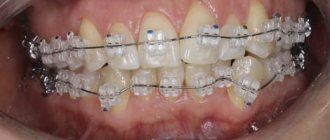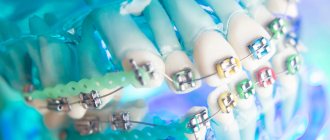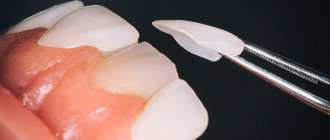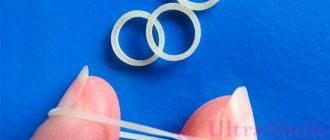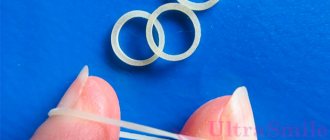Wearing braces is not all you need to straighten your teeth. This is a significant part of orthodontic treatment, quite uncomfortable and complex. However, if, after removing the metal structure, you “leave the teeth to their own devices,” very soon there will be little left of the achieved ideal result. And these are not dentist horror stories. This is a disappointing statistic from the American Dental Association, whose reports indicate that within 10 years after the end of orthodontic correction, indications for re-correction of the bite arise in every second patient.
Teeth are constantly shifting. The jaws and dentition are a dynamic system that is in constant change. If before the start of treatment with braces a person had prerequisites for the curvature of his teeth, these prerequisites will remain in effect after the removal of the corrective structure. This means that teeth that are not fixed in the new position will return to their usual places. Retainers help keep teeth in place.
What is a retainer?
A retainer is an orthodontic device, a splint that unites adjacent teeth into a single system and prevents them from moving. According to their design features and purpose, retainers can be removable or non-removable. Their use allows the patient to undergo complete aesthetic rehabilitation and obtain a stable result of bite correction.
A retainer, just like a braces system, exerts a certain pressure on the dentition. However, the intensity of the impact of this design is much lower; it is only enough to prevent the teeth from moving.
Removable structures include retention guards and plates. They are made from various materials, most often biologically inert transparent silicone or plastic. Fixed retainers are wires or fiberglass that are placed in a groove on the back surface of the teeth and are additionally secured with a composite material. The splint does not unite all the teeth in the dentition, but only the front 6. It is believed that multi-rooted chewing teeth are less susceptible to repeated displacement than incisors and canines.
The cost of mouth guards and plates is almost an order of magnitude higher than that of tires. This is not surprising. They are made individually based on an impression of the patient's teeth. In some cases, an orthodontist, after removing braces, may recommend the use of both types of retainers: splints and mouth guards.
What types of arches are there for braces?
Orthodontic arches differ in different parameters.
According to the shape and diameter of the section
The thinner the cross-section diameter, the thinner and less intense the arc works. Treatment begins with the thinnest arches, as the teeth must get used to the system. At the end of therapy, thick products are placed that completely fill the space in the grooves of the structure.
According to their cross-sectional shape they are:
- round (0.14 - 0.16 inches);
- square (0.16 to 0.175 inches);
- rectangular (0.14-0.25 inches).
Round ones have a less active effect on the process of teeth straightening and are used at the beginning of treatment. The rectangular arch in braces has a medium tension force and is used in the intervals between the use of round and square arches. The square arch has maximum resistance and is installed at the end of therapy.
By purpose and size
According to their purpose, arcs are classified into the following types:
- for upper teeth (Upper);
- for lower teeth (Lower);
- for vestibular braces (standard);
- for lingual braces (individual);
- universal.
The size of the product is selected taking into account the size of the teeth:
- large (Large);
- average (Medium);
- small (Small).
According to the method and material of manufacture
The composition of the alloy used to make the arcs determines the strength, strength and ductility of the wire. The most commonly used materials are:
- stainless steel (SS, D-rect) - the classic, most often used, has a high degree of strength and elasticity, and is affordable;
- titanium and nickel alloy (Ti-Ni) - elastic arcs that exert moderate pressure are used at the beginning of therapy;
- an alloy of titanium, nickel and copper (Cooper Ti-Ni) - ideal for minor bite problems or at the beginning of treatment;
- titanium and molybdenum alloy (TMA) - rigid but quite elastic arches used in the middle and final stages of treatment, rarely cause allergies.
According to the method of making arcs, there are:
- monolithic, made from a single piece of wire - used at the stage of main treatment;
- braided, created from several strands of wire - usually installed at an early stage of correction.
According to the availability of additional functions
In this case, the arcs are divided into the following types:
- with loops for closing interdental spaces caused by the removal of individual teeth;
- with a reversible bend along the curve of Spee, which makes it possible to combine teeth alignment with correction of bite depth;
- with hooks and stops necessary for attaching elastics and springs;
- with torque in the Damon design.
Retainers for permanent wear
The obvious advantage of a lingual retainer is that the patient can forget about the need to use additional structures to consolidate the result of orthodontic treatment. A person very quickly gets used to the wire fixed on the back surface of the teeth and ceases to feel it. It does not interfere with brushing your teeth and does not require special care or medical supervision. The minimum wear period for the splint is 5 years, but it does not need to be removed. Fixed teeth can remain in this position throughout a person’s life without causing discomfort.
Installing the tire requires preliminary preparation. After all elements of the brace system have been removed, the doctor polishes the uneven edges of the teeth, removes bacterial plaque and stone, and fills all carious cavities. And then only the wire is fixed on the incisors and canines. The filling material that holds it in place is carefully polished, making the back surface of the teeth perfectly smooth.
To clean the oral cavity from plaque on a daily basis if you have a permanent retainer, you will have to use special devices. This could be a soft-bristled toothbrush or water flosser. They are necessary in order to thoroughly clean the interdental spaces in the area where the wire is located. About once every 6 months, it is recommended to carry out a professional oral hygiene procedure in order to remove plaque and tartar and saturate the enamel with microelements.
You should not put excessive stress on your teeth: open lids, bite threads, crack nuts. This may cause the retainer to break or become unstuck. If the structure is not repaired in time, the teeth may shift and no longer align.
The cost of making and attaching a permanent retainer is often included in the cost of orthodontic treatment. You can find out the exact price from your doctor.
How much does it cost to replace an archwire on a bracket system?
All brace systems require individual adjustments, tensioning and arch replacement. The cost of replacing a vestibular element in clinics in Moscow and St. Petersburg averages from 2,000 rubles, and a lingual element from 3,500 rubles. If the structure breaks down, the price for repairs, installation and activation of the leveling wire is calculated individually.
The cost of the procedure can be influenced by the system manufacturer:
- replacement of the arc with Ormco – 2500 rubles;
- replacement with 3M Unitec structures - 2800 rubles;
- replacement with American Orthodontics braces - 2900 rubles.
Removable retainers
This type of orthodontic device, as the name suggests, can be installed and removed by a person independently. When worn for a long time, such retainers keep teeth in the correct position and prevent them from moving. To consolidate the results of orthodontic treatment, two types of removable structures are used: plates and mouth guards.
Plates
The plate has a transparent plastic base and metal elements that fix the position of the dentition. Elastic plastic with carefully polished edges is absolutely safe for mucous membranes; wire arches and loops prevent the movement of teeth.
Plates are made for both the upper and lower jaws. A person quickly adapts to the constant presence of a foreign body in the oral cavity. The only problem that most patients note is increased salivation during the first 2-3 days after installation of the structure. Hypersalivation goes away on its own after a short period of time.
The obvious disadvantage of the plates is the ability for a person to remove them and stop using them. It is enough to stop using platinum for just a couple of weeks so that the design made from an impression of the teeth immediately after the removal of braces will no longer be suitable.
Retention guards
Transparent aligners are gradually replacing the use of plates from the daily practice of orthodontists. The fact is that a structure that does not have metal elements is invisible to others. Mouthguards are made from transparent elastic silicone. Thanks to this, the surface of the products has a pleasant wet shine, exactly the same as that of healthy tooth enamel, and does not produce glare in the sun or when photographed with a flash. Mouthguards installed in the mouth cannot be seen even from close range. They don't interfere with talking and smiling. And they can be removed while eating and brushing your teeth.
During the retention period, mouth guards can only be worn at night. However, the more time the structure remains on the teeth, the more reliable the result. The duration of wearing the mouthguard is determined by the attending physician. However, the minimum period turns out to be quite long and is twice as long as the duration of wearing braces.
Preface
- 1 PREPARED by the Federal State Budgetary Institution "Central Research Institute of Dentistry and Maxillofacial Surgery" of the Ministry of Health of the Russian Federation (FGBU "TsNIISiChLKH" of the Ministry of Health of Russia) on the basis of its own translation into Russian of the English version of the international standard specified in paragraph 4
- 2 INTRODUCED by the Technical Committee for Standardization TC 279 “Dentistry”
- 3 APPROVED AND ENTERED INTO EFFECT by Order of the Federal Agency for Technical Regulation and Metrology dated August 22, 2022 No. 936-st
- 4 This standard is identical to the international standard ISO 15841:2014 “Dentistry. Orthodontic wire" (IS015841:2014 "Dentistry - Wires for use in orthodontics", IDT).
When applying this standard, it is recommended to use, instead of reference standards, the corresponding national and interstate standards, information about which is given in Additional Appendix DA
- 5 INTRODUCED FOR THE FIRST TIME
The rules for applying this standard are established in Article 26 of the Federal Law of June 29, 2015 No. 162-FZ “On Standardization in the Russian Federation”. Information about changes to this standard is published in the annual (as of January 1 of the current year) information index “National Standards”, and the official text of changes and amendments is published in the monthly information index “National Standards”. In case of revision (replacement) or cancellation of this standard, the corresponding notice will be published in the next issue of the monthly information index “National Standards”. Relevant information, notices and texts are also posted in the public information system - on the official website of the Federal Agency for Technical Regulation and Metrology on the Internet (www.gost.ru)
© Standardinform, 2017
This standard cannot be fully or partially reproduced, replicated or distributed as an official publication without permission from the Federal Agency for Technical Regulation and Metrology
Caring for removable retainers
Before using trays and plates, the enamel is completely cleaned of plaque and stone. But this does not relieve a person from the need to additionally care for the devices. The trays and plates can be rinsed with water and washed with soap. The use of a toothbrush and toothpaste with abrasive particles is not recommended, as they can scratch the plastic or silicone surface and make it dull. The use of hot water in caring for structures is strictly prohibited, as this can lead to deformation of the product.
It is advisable to use a special container to store the device. Before installing a mouthguard or plate, you need to brush your teeth and rinse your mouth with mouthwash.
Possible problems
During treatment, various problems may arise associated with breakage and deformation of braces:
- During the period of adaptation to the system, individual elements and edges of the arch sometimes rub the mucous membrane of the tongue, gums, and the inner surface of the cheeks and lips. To prevent this complication and eliminate it, orthodontists recommend using a special wax that covers the structure, forming a protective barrier between the braces and soft tissues. If abrasions and irritation have already appeared, you need to rinse your mouth with antiseptic solutions or decoctions of anti-inflammatory herbs.
- The wire begins to lengthen as the teeth move and may begin to dig into the lining of the gums and cheeks. If this happens, there is no need to endure discomfort; it is important to visit an orthodontist to correct the protruding structural elements.
- Part of the arch may fall out or come out of the grooves of the braces as a result of vigorous brushing of the teeth or eating rough food. Sometimes the situation can be corrected using tweezers, with which a piece of wire is simply inserted into the groove of the system, but this action cannot always be performed independently. An orthodontist will help you cope with the problem that has arisen; the main thing is to contact him immediately, since an incorrectly fixed structure will negate the effect of treatment.
- Braces can break due to high chewing loads, maxillofacial trauma to the patient, or poor quality material. In such a situation, arcs are often changed unscheduled. If the wire breaks, you need to make sure that its particles do not get into the human esophagus, since the sharp edges of the wire can damage the surface of the gastrointestinal mucosa.
Content
- 1 area of use
- 2 Normative references
- 3 Terms and definitions
- 4 Classification
- 5 Requirements
5.1 General provisions
- 5.2 Dimensions
- 5.3 Final temperature of austenite
- 5.4 Mechanical properties
- 5.5 Hazardous elements
- 6.1 Sampling
- 7.1 General requirements
Appendix YES (informative) Information on the compliance of reference standards with national
and interstate standards
NATIONAL STANDARD OF THE RUSSIAN FEDERATION Dentistry
ORTHODONTIC WIRE
Dentistry. Wires for use in orthodontics
Date of introduction: 2018—09—01
